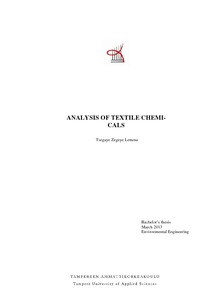Analysis of textile chemicals
Lemma, Tsegaye Zegeye (2013)
Lemma, Tsegaye Zegeye
Tampereen ammattikorkeakoulu
2013
All rights reserved
Julkaisun pysyvä osoite on
https://urn.fi/URN:NBN:fi:amk-2013102916399
https://urn.fi/URN:NBN:fi:amk-2013102916399
Tiivistelmä
Different Chemical analysis methods have been practiced to determine and identify chemicals in textiles. Methods like HPLC, GC-MS, Spectrophotometry and Colorimetry are among the many. As for HPLC, it is a method involves a process of passing a liquid sample over a solid to hold material in a column by applying a flow liquid solvent. In GC-MS two methods are involved, gas chromatography and mass spectrometry in order to identify a test sample. Colorimetric method uses human eyes capability of color perception which is quite similar method as Spectrophotometry except able to reduce spectra to the physical detections of color perception.
This essay discussed and assessed the analytical methods used for the analysis of the four groups of textile chemicals. In this work I assessed the mostly convenient methods to do analysis and also which methods would fit to which textile chemicals concerning time and resource. I was able to answer questions regarding textile chemicals concerning their advantages and potential disadvantages to the environment. The banned chemicals in EU markets and some standard analysis methods that are being used in European Union were also discusses the legislations that are applying in the union regarding the general usage and methods of disposing after.
The research work needs to be done for years before reaching the needed outcomes. For example the researches on azo dyes analyses are done for over two centuries. The large amount of time of continuous research shows that the out coming analytical methods stand on the previous studies. Present research will help to develop the future of chemical analysis methods.
This paper will help to develop analysis methods for future work. Many methods are discussed and analyzed in such a way to fit in the university labs standards. A number of lab works are being made at TAMK on chemical analysis which allows the development of analytical chemistry. These lab works indicates a variety of research that should be done to make such analysis feasible. On such direction one could refer this work in order to investigate what are textiles dyes and how to analyze them that will allow students, professors and scholars learn and solve problems regarding the matters.
Finally, in terms of applications and referring of the work, there are plenty of possible areas in which it can be applied, from guidance of lab work to reference. My specific interest would be to use the thesis to learn more about analytical chemistry.
This essay discussed and assessed the analytical methods used for the analysis of the four groups of textile chemicals. In this work I assessed the mostly convenient methods to do analysis and also which methods would fit to which textile chemicals concerning time and resource. I was able to answer questions regarding textile chemicals concerning their advantages and potential disadvantages to the environment. The banned chemicals in EU markets and some standard analysis methods that are being used in European Union were also discusses the legislations that are applying in the union regarding the general usage and methods of disposing after.
The research work needs to be done for years before reaching the needed outcomes. For example the researches on azo dyes analyses are done for over two centuries. The large amount of time of continuous research shows that the out coming analytical methods stand on the previous studies. Present research will help to develop the future of chemical analysis methods.
This paper will help to develop analysis methods for future work. Many methods are discussed and analyzed in such a way to fit in the university labs standards. A number of lab works are being made at TAMK on chemical analysis which allows the development of analytical chemistry. These lab works indicates a variety of research that should be done to make such analysis feasible. On such direction one could refer this work in order to investigate what are textiles dyes and how to analyze them that will allow students, professors and scholars learn and solve problems regarding the matters.
Finally, in terms of applications and referring of the work, there are plenty of possible areas in which it can be applied, from guidance of lab work to reference. My specific interest would be to use the thesis to learn more about analytical chemistry.
